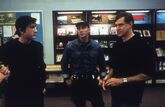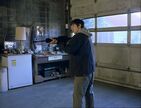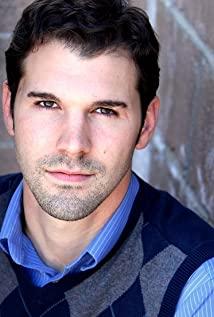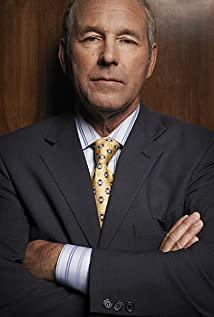"Elephant" has an inherently conflicting image style, and I think maybe it can be referred to as Post-Shake or Post-Pun, and call it post-realism. The 4:3 format and the long shot closely following the characters create the uncertainty of "blind people touching the elephant", and the non-linear multi-line narrative repeatedly impacts the audience, clarifying the omniscient and omnipotent perspective of the narrator; the characters and actors have the same name, and the design of most improvisations is intentional. The connection with the real is closer, the exquisite lens scheduling, the water wave sound effects of the departure, and the electronic soundtrack make the image condense a layer of surreal film; "events" and traditional effective information are very few, and they are displayed in a large space. daily actions. They show the power of the author everywhere, and at the same time emphasize the presentation of real time and space, so the "recovery of material reality" has indeed become a media expression criterion that is tightly woven and reborn into reality through the narrator here. There are many single scenes in the film that are repeated from different camera positions, some from different character perspectives, and some from different camera (narrator) perspectives. The fixed empty shot of the first shot at the beginning can be the latter, but from the appearance of Michelle from the back, it can be deduced that it is her character perspective. And this scene is confirmed as the same space by the shouts of the players passing the ball. Cleverly, the scene is hinted at the same time as Alex playing the piano through the background "To Alice" soundtrack. After that, there was a follow-up shot of Nathan for nearly ten minutes. In such a group play, the author abandoned the traditional characterization and replaced it with the most basic human walking. The audience walked through the campus with him. Feeling his daily life, this diachronic display has become our almost all substitution channel for Nathan. At the end, Alex was reading the song in the cold storage door, and he didn't even need to give Nathan & When Carrie counterattacks and the audience is worried enough, more synchronic characterizations are unnecessary here. But in the shaping of the most important character of this movie, Alex, it seems to be a little revealing... From being bullied by good students in class, to cleaning the toilet, to stepping in the cafeteria and making plans-this character line is more than others. The character's time period is long and seems to be pushed forward by a few days; if you follow the timeline, it completes the character action process of Alex being bullied, having nowhere to vent, being incited, and revenge, even if we assume that he has been bullied many times before, But shrinking it down to one day would be too hasty, and stretching the timeline would destroy the overall temporal unity of the film. Because his behavioral kinetic energy is the greatest, his foreshadowing is much more rigid than other roles, as if his motivation is laid out on the timeline - the bullying incident mentioned earlier, watching Nazi documentaries, violent games and buying guns Correlation, the backlog of evil and anger in human nature, and the unseen harm are indeed shown, but it can always be more imaginative. "To Alice" is much better integrated with the shooting game, and the last time it appeared as a background music unrelated to the scene was the stadium. Michelle and Nathan were in the same sun, but he couldn't understand the cold violence she suffered, She can't be as happy and comfortable as he is; on the other hand, Eric, who may have suffered discrimination and bullying because of his homosexuality, vented himself in the game. And Alex, who dominates this melody, is like telling for whom the death knell tolls, from the game screen to the real screen, the prelude of death is also the finale of death.
And when the school massacre of the two of them came as scheduled, the first person who died at the gunpoint turned out to be Michelle, who suffered the same school violence and was at the bottom of this small society. This is the cruelest scene in the film. When they're first in high positions of power, they look around and sure enough, they start with a sheep.
And Elias, who is holding the camera, is still pressing the shutter at the moment, which is also a cruel irony - he has always had great enthusiasm for documenting beauty, just as he is happy to show kindness to everyone, but only if she is also Happy to be watched, willing to give feedback of kindness or other emotions. And those marginalized people represented by Alex and Michelle, we won't see in Elias's camera when they are bullied or cold violence; they have shrunk themselves into hedgehog shape, unable to release their emotions, and it is even more difficult to receive Elias's feelings bona fide. So the only thing he recorded was Alex's only emotional release, an inescapable evil deed...
What can be seen, what can be heard is a character like John, who represents the average person in this school. He can show kindness to the people around him, but the alcoholic father and the unsympathetic teacher are indeed enough to make this young man cry. What about Michelle, Alex, Eric and their teachers? The movie has already done it twice. , how their family, can only let us associate. Nathan is also a normal person, only he is more charming and more noticeable, and maybe this is also related to his turning a blind eye to the bullying suffered by his classmate Alex. As for John, he's not that bad, so he's qualified to release goodwill, befriend Elias, get into his camera, and get Acadia's comforting kiss. His character line also disproves the vicious circle that those marginalized people live here, and the film repeats three different camera positions in a scene, and the different fates of the characters emerge to the surface - John intends to relax outside the school, and Elias finishes washing The photos are going to the library to pass the time, and Michelle also wants to go to the library for a part-time job. John greets Elias in this scene and invites him to take a photo, so they still don't notice Michelle trotting past. So John seems destined to be the kindhearted guy who warns his surroundings, Michelle is destined to experience this last neglect, and Elias is destined to stand there and record Alex's first opening on camera.
The line of Elias is like the indictment of the film. The record of photography is the selective record of the public's daily life around the world: feedback kindness in the face of goodness, know how to preserve the pursuit of beauty, and witness the indignation of evil deeds. Yet structural problems are always there, and we always ignore them; we also turn a blind eye to these emotional transformations, seeing them as uninterrupted incidents. All media shape people’s perspective of “banality and evil” to varying degrees. The games, TV, and music that appear in the film are all the same. Then the capitalist world will commodify all behaviors with the Nazis’ burning of books and censorship. The difference is that the former is not a physical violent machine, but an elephant in the room, and we can only feel a part of the elephant like a blind person.
View more about Elephant reviews











